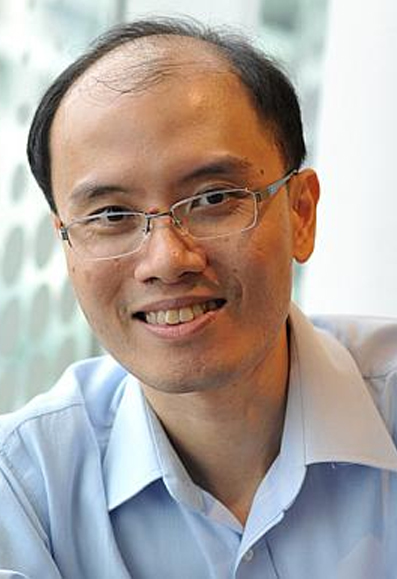
Affiliations
Adjunct Professor, Department of Biochemistry, Yong Loo Lin School of Medicine, NUS.
Acting Executive Director, Genome Institute of Singapore (GIS), A*STAR.
Deputy Director (Research Programmes), Genome Institute of Singapore (GIS), A*STAR.
Senior Group Leader, Genome Institute of Singapore, A*STAR.
Adjunct Associate Professor, School of Biological Sciences, NTU.
Adjunct Associate Professor, Department of Biological Sciences, Faculty of Sciences, NUS.
Education
| Degree and Institution | Year(s) |
| PhD, University of Edinburgh, UK | 1996-1999 |
| B.Sc (Honours 1st class) National University of Singapore | 1992-1996 |
Professional Experience
| Position and Institute | Year(s) |
| Executive Director (Genome Institute of Singapore) | 2012–present |
| Senior Group Leader, Genome Institute of Singapore | 2007–present |
| President, Stem Cell Society (Singapore) | 2010–present |
| Adjunct Professor (School of Biological Sciences, Nanyang Technological University) | 2011–present |
| Adjunct Professor (Department of Biochemistry, National University of Singapore) | 2012–present |
| Adjunct Professor (Department of Biological Sciences, National University of Singapore) | 2012–present |
Research Interest
NgHH’s laboratory focuses on different aspects of Systems Biology of Stem Cells. Specifically, his group uses genome wide approaches to dissect the transcriptional regulatory networks in embryonic stem cells with the aim to identify key nodes in this network. This had led to the first paper on the whole genome and unbiased mapping of key transcription factors in mouse embryonic stem cells. His group also conducted the whole genome genetic screen for human embryonic stem cells. More recently, his lab has begun to investigate the reprogramming code behind the induction of pluripotency in somatic cells. Huck-Hui Ng’s works have been published in journals such as Cell, Science and Nature. He also sits on the Editorial Board of International Journals such as Cell, Cell Stem Cell, Genes & Development. His papers have received over 14,000 citations and his H-index is 45.
Selected Publications
- Chan et al (2013). Induction of a Human Pluripotent State with Distinct Regulatory Circuitry that Resembles Preimplantation Epiblast. Cell Stem Cell. 13(6):663-75. (IF: 25.94)
- Lu et al (2013). SON connects the splicing-regulatory network with pluripotency in human embryonic stem cells. Nature Cell Biology. 15(10):1141-52. (IF: 19.41)
- Goke et al (2013). Genome-wide Kinase-Chromatin Interactions Reveal the Regulatory Network of ERK Signaling in Human Embryonic Stem Cells. Mol. Cell. 50(6):844-55. (IF: 14.2)
- Karwacki-Neisius et al (2013). Reduced Oct4 Expression Directs a Robust Pluripotent State with Distinct Signaling Activity and Increased Enhancer Occupancy by Oct4 and Nanog. Cell Stem Cell. 12(5):531-45. (IF: 25.94)
- Ng et al (2013). In vivo epigenomic profiling of germ cells reveals germ cell molecular signatures. Dev Cell. 2013 Feb 11;24(3):324-33. (IF: 14.03)
- Gonzales and Ng (2011). FoxO: A new addition to the ESC cartel. Cell Stem Cell. 9(3):181-3. (IF: 25.94)
- Ng and Surani (2011). States of Pluripotency: transcriptional and signaling networks. Nature Cell Biology. 13(5):490-6. (IF: 19.41)
- Ng and Ng (2010). LincRNAs join the pluripotency alliance. Nature Genetics. 42(12):1035-6. (IF: 36.38)
- Chia et al (2010). A genome-wide RNAi screen reveals determinants of human ES cell identity. Nature. 468(7321):316-20. (IF: 36.10)
- Kunarso et al (2010). Transposable Elements have Rewired the Core Regulatory Network of Human Embryonic Stem Cells. Nature Genetics. 42(7):631-4. (IF: 36.38)
- Agarwal et al (2010). Telomere elongation in dyskeratosis congenital induced pluripotent stem cells. Nature. 464(7286):292-6. (IF: 36.10)
- Heng et al (2010). The Nuclear Receptor Nr5a2 can replace Oct4 in the Reprogramming of Murine Somatic Cells to Pluripotent Cells. Cell Stem Cell. 6(2):167-74. (IF: 25.94)
- Han et al (2010). Tbx3 improves the germ-line competency of induced pluripotent stem cells. Nature. 463(7284):1096-100. (IF: 36.10)
- Feng et al (2009). Molecules that promote or enhance reprogramming of somatic cells to induced pluripotent stem cells. Cell Stem Cell. 4(4):301-12. (IF: 25.94)
- Feng et al (2009). Reprogramming of fibroblasts into induced pluripotent stem cells with orphan nuclear receptor Esrrb. Nature Cell Biol. 11(2):197-203. (IF: 19.41)

